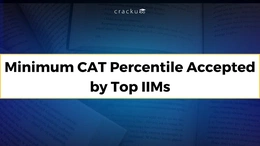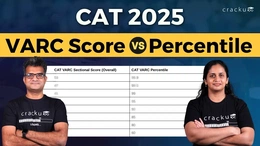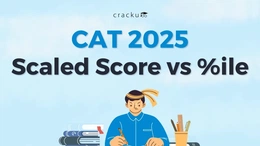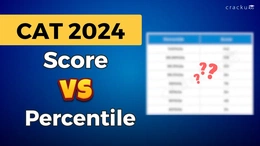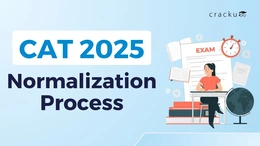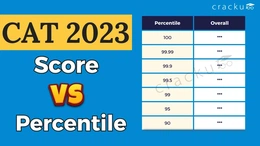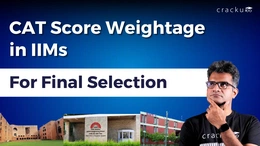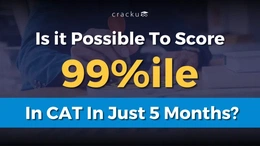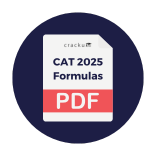CAT Score vs Percentile 2025
CAT is one of the most competitive MBA entrance exams in India. Over 3 lakh candidates registered for CAT 2024. This year the no. has decreased a bit to 2.93 lakhs registration. The exam includes three sections and lasts for 120 minutes. It follows a scaled scoring system that can be confusing. Every year, aspirants look for clarity between the score and the percentile. Understanding how raw scores convert to percentiles helps plan a strategy. Based on past trends, a raw score of 96-98 or above can lead to a 99+ percentile. This blog breaks down the difference, expected data for 2025, and comparisons from the previous year. Use this data to set realistic score targets and track performance accurately. If you are looking to take CAT 2025, getting yourself enrolled in a CAT online coaching is a good option.
Check Slot-wise CAT answer key on the below-given links:
| CAT Slot-wsie Answer Key | ||
| CAT 2025 Slot 1 Answer Key | CAT 2025 Slot 2 Answer Key | CAT 2025 Slot 3 Answer Key |
CAT Score vs Percentile 2025 (Expected)
The CAT percentile reflects the percentage of candidates who scored less than a particular score. A percentile is not a direct representation of marks. A high raw score does not guarantee a high percentile without normalisation. Percentiles are calculated after applying scaled scores and slot-wise normalisation. The competition level and exam difficulty affect score-to-percentile conversion, which varies each year.
A score near 95 marks is typically required to reach the 99th percentile. It varies from year to year depending on the difficulty level of the CAT exam.
Also Read, CAT Score vs Percentile 2024, Section-wise Percentiles
CAT 2025 Score vs Percentile (Expected)
Based on the CAT 2025 analysis and patterns similar to recent CAT exams, the following table shows the section-wise expected score vs percentile. These estimates are derived from the difficulty level reflected in CAT exam and past-year trends.
This table covers VARC, DILR, QA, and Overall scores helping candidates understand what score range may convert into which percentile.
| Percentile | VARC scaled score | LRDI scaled score | Quants scaled score | Total scaled score |
| 99.99% | 60.34 | 50.77 | 48.83 | 132.79 |
| 99.95% | 54.60 | 43.41 | 42.84 | 118.37 |
| 99.90% | 53.01 | 41.47 | 39.02 | 112.48 |
| 99.50% | 46.48 | 33.49 | 31.22 | 94.44 |
| 99.00% | 42.77 | 29.71 | 27.08 | 85.85 |
| 98.00% | 38.42 | 26.85 | 23.9 | 76.98 |
| 97.00% | 36.33 | 24.22 | 21.85 | 72.45 |
| 95.00% | 32.52 | 21.53 | 18.96 | 65.49 |
| 90.00% | 26.18 | 17.26 | 14.65 | 53.81 |
| 85.00% | 22.12 | 13.88 | 12.58 | 46.33 |
| 80.00% | 19.21 | 11.63 | 10.36 | 40.87 |
| 75.00% | 17.04 | 10.5 | 9.41 | 36.07 |
| 70.00% | 14.31 | 8.25 | 7.44 | 31.37 |
| 65.00% | 12.98 | 6.91 | 6.36 | 27.83 |
| 60.00% | 11.02 | 5.95 | 5.33 | 24.86 |
| 55.00% | 9.94 | 4.87 | 4.35 | 22.14 |
| 50.00% | 8.83 | 4.12 | 3.68 | 19.77 |
| 40.00% | 5.89 | 2.3 | 2.22 | 15.23 |
| 30.00% | 3.84 | 0.47 | 0.81 | 10.72 |
| 20.00% | 0.76 | -1.36 | -0.79 | 5.41 |
| 10.00% | -3.26 | -4.1 | -3.01 | -1.59 |
| 5.00% | -6.3 | -6.4 | -5.03 | -6.84 |
| 1% | -8.46 | -9.05 | -7.11 | -11.56 |
CAT 2025 VARC Score Vs Percentile
Based on the CAT 2025 VARC expected analysis and past exam trends, the table below shows the section-wise expected score vs percentile for VARC score. These estimates are prepared using difficulty level and previous years’ data to help students understand which score range may correspond to each percentile.
| Percentile | VARC Scaled Score |
|---|---|
| 99.9 | 53.01 |
| 99.5 | 46.48 |
| 99 | 42.77 |
| 95 | 32.52 |
| 90 | 26.18 |
85 | 22.12 |
| 80 | 19.21 |
| 60 | 11.02 |
Also Read, CAT VARC Score vs Percentile 2025, Check Ideal VARC Score
CAT 2025 DILR Score Vs Percentile
Based on the CAT 2025 LRDI expected analysis and past exam trends, the table below shows the section-wise expected score vs percentile for LRDI score. These estimates are prepared using difficulty level and previous years’ data to help students understand which score range may correspond to each percentile.
| Percentile | DILR Score |
|---|---|
| 99.9 | 41.47 |
| 99.5 | 33.49 |
| 99 | 29.71 |
| 95 | 21.52 |
| 90 | 17.26 |
85 | 13.88 |
| 80 | 11.63 |
| 60 | 5.95 |
Also Read, CAT DILR Score vs Percentile 2025, Check Ideal VARC Score
CAT 2025 Quantitative Aptitude Score Vs Percentile
Based on the CAT 2025 QA expected analysis and past exam trends, the table below shows the section-wise expected score vs percentile for Quants score. These estimates are prepared using difficulty level and previous years’ data to help students understand which score range may correspond to each percentile.
| Percentile | QA Score |
|---|---|
| 99.9 | 39.02 |
| 99.5 | 31.22 |
| 99 | 27.08 |
| 95 | 18.96 |
| 90 | 14.65 |
| 85 | 12.58 |
| 80 | 10.36 |
| 60 | 5.33 |
Also Read, CAT Score vs Percentile 2023, Raw & Scaled Score Analysis
CAT Score vs Percentile 2025: What is the difference?
The raw score is the total of marks based on correct and incorrect answers. A percentile is the relative rank among all candidates. Percentile uses scaled scores after normalization across slots. The raw score depends on the number of questions answered correctly and incorrectly. The percentile shows where a candidate stands among all test-takers.
| Metric | Meaning |
| Raw Score | Direct total from the candidate's answers |
| Scaled Score | Adjusted score after slot normalization |
| Percentile | Rank in comparison to other test-takers |
Percentile helps MBA colleges compare candidates fairly across slots.
CAT Score vs Percentile Previous Year Analysis
Analyzing previous year data helps identify trends. Small changes in raw scores can lead to large percentile jumps. In difficult years, even a lower raw score can fetch a high percentile.
| Year | 99.9 %ile | 99 %ile | 95 %ile | 90 %ile |
| 2024 | 127 | 95.13 | 70 | 58 |
| 2023 | 101.43 | 76.15 | 54.86 | 44.36 |
| 2022 | 109 | 84 | 62 | 49 |
Percentile cutoffs reflect difficulty variation across years.
CAT Score vs Percentile 2024
CAT 2024 followed the usual format with three sections. VARC was slightly tougher than in 2023. DILR remained moderate. QA saw mixed reactions.
| Percentile | VARC Score | DILR Score | Quant Score | Overall |
| 99.9 | 55 | 50.1 | 45 | 127 |
| 99.5 | 44 | 41.4 | 36.5 | 103.97 |
| 99 | 40.3 | 37.8 | 33 | 95.13 |
| 97 | 33.54 | 30.8 | 25 | 78.9 |
| 95 | 30 | 27 | 22 | 70 |
| 90 | 24 | 22.5 | 17 | 58 |
| 85 | 20.42 | 19.5 | 13.7 | 50 |
| 80 | 18.2 | 17 | 11.6 | 44 |
| 75 | 15.60 | 14.95 | 9.92 | 40 |
Aspirants needed a balanced performance across all sections to reach higher percentiles.
CAT Score vs Percentile 2023
CAT 2023 had slightly easier VARC and tougher DILR & QA. The overall difficulty led to slightly lower scores for high percentiles.
| Percentile | VARC Score | DILR Score | Quant Score |
| 100 | 61.66 | 50.4 | 49.46 |
| 99.99 | 58.20 | 42.66 | 44.89 |
| 99.9 | 51.14 | 36.58 | 34.96 |
| 99.5 | 44 | 30.58 | 28.28 |
| 99 | 39.83 | 27.29 | 25.20 |
| 95 | 28.78 | 18.92 | 16.87 |
| 90 | 23.37 | 15.63 | 13.63 |
| 80 | 17.58 | 11.67 | 9.2 |
Normalization helped balance difficulty differences across slots.
CAT Score vs Percentile 2022
CAT 2022 was moderate in difficulty. DILR was particularly challenging. VARC was easier for some slots, and QA was average.
| Percentile | Raw Score (Overall) |
| 99.9 | 110 |
| 99 | 84 |
| 95 | 60 |
| 90 | 49 |
| 85 | 41.32 |
| 80 | 36.02 |
CAT 2022 showed how difficulty can impact percentile jumps.
Also Read, How Many Questions will get you 99 Percentile in CAT?
How to Convert a CAT Score to a Percentile?
CAT percentile uses scaled scores, not raw marks. The formula is:
Percentile = [(Total Candidates - Rank) / Total Candidates] × 100
The exact formula includes scaled scores and is applied post-normalization. Slot-wise variation is considered to ensure fairness. A higher raw score increases the scaled score. A higher scaled score improves the percentile. The process remains confidential but follows statistical principles.
Also Read, CAT Form Filling 2025, Documents Required, Form Fees, Steps
What is the Raw Score in CAT?
Raw score is the sum of marks gained from correct answers minus penalties. Each correct answer adds +3 marks. Each incorrect MCQ deducts 1 mark. No negative marking applies for non-MCQs. Raw score gives a base number before scaling.
| Response Type | Marks Awarded |
| Correct Answer | +3 |
| Incorrect MCQ | -1 |
| Incorrect TITA | 0 |
| Unanswered | 0 |
Raw score reflects actual performance in the slot.
What is the Scaled Score in CAT?
Scaled score adjusts raw score based on the difficulty of the slot. Each slot may have variations in questions. IIMs normalize scores using statistical models. The scaled score is used to calculate the percentile. Section-wise and total scores undergo scaling.
| Component | Purpose |
| Raw Score | Candidate’s unadjusted performance |
| Scaled Score | Adjusted for slot difficulty |
| Percentile | Relative standing among candidates |
Scaled score ensures fairness across slots and time slots.
CAT Normalization Process 2025
The CAT is conducted in multiple slots on the same day, and the difficulty level of each slot can vary. To ensures that the process to be fair among all test-takers, the normalization process is used. This process adjusts scores across different slots, so candidates are neither advantaged nor disadvantaged due to the slot they have taken test in.
How Normalization Works:
- Raw Scores: First, your raw score is calculated based on correct answers (+3 marks), incorrect answers (-1 for MCQs), and no negative marking for TITA (non-MCQ) questions.
- Slot-wise Statistics: For each section (VARC, DILR, QA), the average and standard deviation of raw scores are computed separately for each slot.
- Scaling: Your score is then adjusted using a mathematical formula that considers:
- The slot-wise mean and standard deviation.
- The performance of the top 0.1% candidates in each slot.
This ensures that a tougher slot doesn’t lead to lower percentiles.
- Percentile Calculation: Finally, your percentile is calculated based on your rank among all test-takers.
Formula Used in Calculating CAT Percentile and Scaled scores
The following formula is used for calculating scaled score:
Normalized Score = μ + ( X - μs⁄σs ) × σ
Where:
- X = Raw score of the candidate in that section
- μs = Mean score of the candidates for the session
- σs = Standard deviation of scores in the session
- μ = Mean score of all candidates across all sessions
- σ = Standard deviation of all candidates across all sessions
After normalizing the scores, use the following formula to calculate the percentile:
Percentile = ( N - R⁄N ) × 100
Where:
- N = Total number of candidates who appeared for CAT in that particular slot/section
- R = Rank of the candidate (based on normalised score, in descending order)
CAT Score vs Percentile 2025: Conclusion
Understanding the CAT score vs percentile pattern is essential. Score-to-percentile mapping changes each year based on difficulty and candidate pool. Historical trends suggest a score of around 95–100 is needed for a 99+ percentile. Candidates must aim for consistent performance across sections. Using past data helps set realistic goals. Focus on accuracy, speed, and mock tests. Percentile is the key metric for B-school selection. Track raw scores in practice exams to estimate future percentile accurately.




